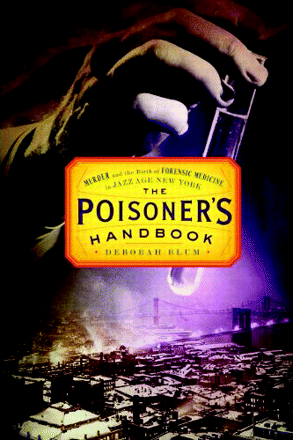Two Who Dared
- John Nelson, PhD

The Poisoner’s Handbook: Murder and the Birth of Forensic Medicine in Jazz Age New York Deborah Blum The Penguin Press: New York; 2010. 336 pages. $25.95 ISBN-13: 978-1594202438
First a confession: Although an inveterate reader for pleasure, I’m usually able to enjoy no more than twenty or thirty pages when reading at night. Too soon, I fall asleep (although not for lack of interest). There have been two recent exceptions, when I was indeed robbed of sleep. Staying up most of the night, I read avidly Geoffrey Householder’s Rogue Male, the breath-taking classic of cat and mouse, the hunter turned hunted. The second book, which commanded my attention in a similar manner, was Deborah Blum’s more recently published The Poisoner’s Handbook.
The state of medical forensics in the US at the beginning of the twentieth century was appalling. In New York City, the political machine of Tammany Hall anointed friends with lucrative positions. It took the corrupt Mayor Hylan to appoint a man as unfit to lead the Office of Chief Medical Examiner as was Patrick Riordan. During Riordan’s watch over New York City, as was also the case of his predecessors, hundreds if not thousands of deaths (suspicious or natural) were misreported by coroners. Indeed, one did not need to be a practicing physician to hold a coroner;s license real estate brokers and plumbers were easily qualified and many causes of death as listed on official certificates gave testimony either to disinterest or wild ignorance in the person of the coroner. For example, one apparent cause of death was chalked up to “diabetes, tuberculosis, or nervous indigestion,” and another was deemed an “act of God.” With corruption and incompetence running so high, even the New York Governor could no longer turn a blind eye, and Riordan was removed from office.
Subsequent to Riordan’s ousting, the position of Chief Medical Examiner of New York City fell to Charles Norris, who was determined to raise the profile and efficiency of the office and its mission. And Norris was in a position to do so. A wealthy man, he did not hesitate to battle the political machinery that surrounded him, and he literally paid the price of his defiance. Understaffed and underfunded, Norris, remained undeterred by political disfavor, and he paid out of his own pocket for laboratory equipment and renovations, even to the point of personally supplementing the pay of several physicians who worked for his office. Norris was determined to create an examiner’s office that would rely on toxicology and chemistry to assist the police in determining the guilt or innocence of defendants. One of the best decisions that Norris made while in office was to hire Alexander Gettler as his forensic chemist. Gettler matched his boss’s determination and was hugely competitive. He “hated to give up on a chemical analysis, and he positively hated the idea that some poisoner off the street could outwit him.”
“If a new poison or drug came on the market, [Gettler] went off to the butcher shop, just around the corner from his Brooklyn home, and bought three pounds of liver. He would arrive at Bellevue carrying his twine-wrapped and bloodstained parcel under his arms.”
Blum’s book is divided into chronologically progressing chapters; each chapter is titled with a poison whose use was prevalent within that time period or culminated in a specific court case. Ranging from wood alcohol (infamous during Prohibition) to chloroform (easily obtained by prescription) to radium (an inadvertent and tragic element used in painting watch dials) to carbon monoxide (from extraordinary vehicular traffic), each poison is described, first in terms of how and why it was employed (not always by murderers) and the assays that Gettler developed to identify toxic compounds in tissues. Blum offers an intriguing view of the basic science and scientific evidence that was presented before the court and jury in the days before society had become sophisticated about such matters. Blum tells us of Gettler’s satisfaction of providing compelling evidence to convict a defendant (in the “Thallium” chapter) who, twelve years before, had walked free because of refutable evidence (in the “Arsenic” chapter).
“…A man of fortunate birth, of scientific training, and intellectual tastes, he added to these advantages a broad acquaintance with human nature, a fine sense of humor and proportion, and democratic habits, which equipped him for success in any field, and were particularly fortunate in his work as Chief Medical Examiner of the City of New York. The abuses and absurdities of the old Coroner’s system he replaced with a modern organization covering all the necessary branches of legal medicine, extended the service in a systematic manner over the entire metropolitan area, introduced high standards of scientific investigation, and placed the department on a par with the best existing in any large city in the World. He accomplished all this in an unfamiliar political atmosphere which was merely tolerant, and by dealing wisely and firmly with agents who could have little knowledge…”
From Dr Norris’s obituary, Charles Norris, MD (1867–1935) Bulletin of the New York Academy of Medicine
The source material that Blum draws on will be of great interest to readers with a biomedical bent. But for a non-fiction book to be successful and captivating, it is not sufficient for the source material to be interesting. The author must have a talent for finding the story around the material and for writing in an engaging style. Blum is such an author, and The Poisoner’s Handbook is simply the best non-fiction book I’ve read this year.
Norris and Gettler, as portrayed by Blum, are exemplars for the scientists and clinicians of our own time. The traits of honesty and curiosity and intelligence that she brings forth in her protagonists, all within the context of scientific inquiry, will be recognized by students and professionals in biomedicine. Blum belongs to those gifted non-fiction writers who validate scientist readers and the ideals they bring to scientific research and medical practice.
Deborah Blum is the author of several books and has won the Pulitzer Prize for beat reporting, which culminated in the writing of her book The Monkey Wars.

- Copyright © 2010



